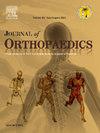What is the multifactorial efficacy of day-zero ambulation post-total hip replacement surgery: A systematic review
IF 1.5
Q3 ORTHOPEDICS
引用次数: 0
Abstract
Objective
To examine the multi-factorial efficacy of day-zero ambulation following primary total hip arthroplasty.
Data sources
MEDLINE, CINAHL, AMED, EMBASE and APA PsychInfo in accordance with PRISMA guidelines.
Review methods
Studies were classified for study design and ranked in a hierarchy of evidence. Studies ranked excellent or good who followed a treatment pathway inclusive of day-zero ambulation were appraised using the appropriate content checklist (PRISMA, CONSORT, STROBE), CASP checklist and where possible for risk of bias using the appropriate tool (RoB 2.0, ROBINS-1). Results were produced using a narrative synthesis.
Results
A total of 8 studies met inclusion criteria. Studies reported a consensus of a reduced length of hospital stay in pathways where day-zero ambulation was included, but with varying effect sizes. Findings suggested that day-zero ambulation may speed up return to function following THR. There was not enough evidence to provide synthesised results on financial efficiency, post-operative pain, or safety of day-zero ambulation via post-operative complications.
Conclusions
This systematic review reveals limitations within the literature base on day zero-ambulation. There are problems of concomitant interventions, methodological heterogeneity, and an abundance of research low in the evidence hierarchy. Day zero-ambulation shows promise in reducing length of hospital stay and there is suggestion that it accelerates functional recovery. However, to establish this with rigor, there is further need for high quality, prospective studies such as RCTs to examine the multi-factorial effect of day-zero ambulation, challenge existing theories and contribute to confident synthesised findings more useful to clinical decision makers.
全髋关节置换术后零日行走的多因素疗效如何?系统回顾
数据来源MEDLINE、CINAHL、AMED、EMBASE和APA PsychInfo,符合PRISMA指南。综述方法根据研究设计对研究进行分类,并按证据等级进行排序。采用适当的内容检查表(PRISMA、CONSORT、STROBE)和 CASP 检查表,并在可能的情况下使用适当的工具(RoB 2.0、ROBINS-1)评估偏倚风险。结果共有 8 项研究符合纳入标准。研究报告一致认为,在纳入了日间负重行走的路径中,住院时间有所缩短,但效果大小不一。研究结果表明,日间零距离行走可加快全脊椎十字路口术后功能的恢复。目前还没有足够的证据来综合说明日间负重对经济效益、术后疼痛或术后并发症安全性的影响。存在同时干预、方法异质性以及大量证据等级较低的研究等问题。日间零距离行走有望缩短住院时间,而且有迹象表明它能加快功能恢复。然而,要严格确定这一点,还需要进行高质量的前瞻性研究,如研究性试验,以检查日间零负重行走的多因素影响,对现有理论提出质疑,并为临床决策者提供更有用的综合研究结果。
本文章由计算机程序翻译,如有差异,请以英文原文为准。
求助全文
约1分钟内获得全文
求助全文
来源期刊

Journal of orthopaedics
ORTHOPEDICS-
CiteScore
3.50
自引率
6.70%
发文量
202
审稿时长
56 days
期刊介绍:
Journal of Orthopaedics aims to be a leading journal in orthopaedics and contribute towards the improvement of quality of orthopedic health care. The journal publishes original research work and review articles related to different aspects of orthopaedics including Arthroplasty, Arthroscopy, Sports Medicine, Trauma, Spine and Spinal deformities, Pediatric orthopaedics, limb reconstruction procedures, hand surgery, and orthopaedic oncology. It also publishes articles on continuing education, health-related information, case reports and letters to the editor. It is requested to note that the journal has an international readership and all submissions should be aimed at specifying something about the setting in which the work was conducted. Authors must also provide any specific reasons for the research and also provide an elaborate description of the results.
 求助内容:
求助内容: 应助结果提醒方式:
应助结果提醒方式:


